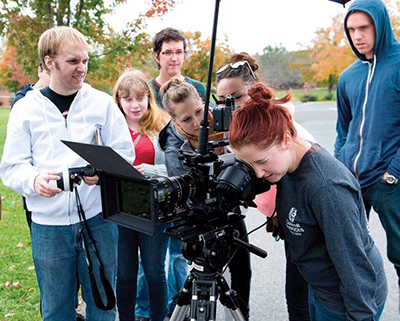The Arri Alexa XT Plus Cinema Camera

The Arri Alexa XT Plus is put through its paces by the author’s DeSales University television and film students.
It’s not often I get the chance to review a camera of this stature—the last time I used an Arriflex camera in this magnitude was when I shot 35 mm motion picture film. And quite honestly, this camera creates digital images just as pristine and at a fraction of the cost of its film camera brother.
FEATURES
Arri has several Alexa models, including the Classic, XT, XTM, XT Plus, and the XT Studio). The Alexa XT (Extended Technology) Plus, which was targeted for this review, has a few features unique to its class, including the capture of images in ArriRAW at up to 120 fps. When used with a 512 GB XR hard drive, the XT Plus can record images in Apple Pro Res 4444 (up to 107 minutes at 24 fps) or Avid’s DNxHD.
If you’re not using the XR drive, the XT Plus can also capture footage up to 120 fps in ProRes HQ onto SxS Pro cards with the use of an adapter. The camera does have variable frame rates and numerous other export options. The option of recording in Arriraw is helpful if you need uncompressed footage.
The Alexandra XT is switchable between 16:9 and 4:3 aspect ratios—the Super 35 mm sensor is 4:3 which is the same shape as a 4-perf Super 35 film frame and used mostly for theatrical releases. This could be one of the reasons that this camera is used in the production of a long list of Hollywood film and television projects.
When the camera is in use, there is a screen on the operator’s right side that displays pertinent information, which includes the frame rate, shutter speed, white balance and exposure index. Timecode, battery voltage, capture format, the geographic location of the content being captured and shot duration are also provided for the convenience of the operator and others involved in the production. The SDI outputs are available on BNC connectors. The lens used in this test was an Arri Alura 30-80 mm T2.8 zoom made by Fujinon and controlled by a WCU-4 wireless follow focus device.
All camera functions can be saved to an SD card if more than one user needs to access pertinent information.
IN USE
Besides being a beautiful camera to look at, it also produces some amazing images. For my evaluation I mounted the camera on the strongest tripod available—a Matthew’s Doorway Dolly and added tracks for smoother shooting. With conditions changing from a cold drizzle to a brilliant, cloudless sky in a matter of two hours, we kept the lighting people busy.
The two stars of the demonstration shoot—other than the XT Plus camera, of course—were a 1963 Corvette Stingray convertible and a 2000 Corvette convertible. As the cars left the starting point, traveling side by side, I dollied the Alexa back to follow them. The wireless follow focus was critical, not only because the depth of field was shallow, but also because the sun was constantly playing hide and seek with us that day.
As I wanted to create a movie within a movie, the entire shoot was captured with another super 35mm sensor camera, the Canon EOS C100. It was very important to our production that the log files captured on the C100 could be intercut with the footage shot with the Alexa (a camera costing nearly $200,000 including batteries, accessories, and a 2575 O’Connor tripod).
As we don’t have access to cameras of this price range frequently, we had to scramble to keep the Alexa fed with the type of “fuel” that it requires in location shooting service. The school has only two Anton/Bauer brick batteries and both will keep the Alexa running for less than 30 minutes. We opted to use AC power delivered via a very long extension cord to keep the camera humming for our evaluation testing.
The old adage that you get what you pay for couldn’t be truer when shooting with the Alexa XT Plus. The images in the heated viewfinder rivaled those of the 35 mm motion picture behemoths of old. It’s really true that the sensor and the glass make all the difference with a camera. If you light correctly, almost any footage can look better—but the Corvettes we were capturing never looked this great, even in real life.
I did find the camera to be somewhat finicky in that the setup and teardown times were greatly extended due to the unit’s girth and complexity; this is not the camera of choice for one-person operations. Also, I found that the remote unit batteries weren’t really as long-lasting as I might have liked. As for the learning curve, it’s not really that steep, but is somewhat longer than with other cameras I’ve used due to the amount of control (ability to vary settings) in producing your recorded images.
All in all, if it’s the best camera available that you’re looking for, I couldn’t even begin to offer another contender for that title.
SUMMARY
If you want the kind of quality and sharpness that professionals demand in their cameras, you would be hard pressed to find a better example than what the Arri folks are offering in their Alexa XT Plus.
Chuck Gloman is an associate professor and chair of the TV/Film department at DeSales University. He may be reachedchuck.gloman@desales.edu.
FAST FACTS
APPLICATION
Cinema production, very high quality capture of nearly any event
KEY FEATURES
Multiple recording and output options, ability to tailor parameters of any shooting environment to your needs and save that information, production of digital footage that very closely captures what the human eye sees.
PRICE
All prices are MSRP: Alexa XT Plus camera body, $78,600; Fujinon 30-80 mm T2.8 zoom lens, $26,930; XR drives, remotes, licenses, cables and hardware, $49,287
CONTACT
Arri
845-353-1400
www.arri.com
Get the TV Tech Newsletter
The professional video industry's #1 source for news, trends and product and tech information. Sign up below.
Chuck Gloman is Associate Professor with the TV/Film Department at DeSales University.

